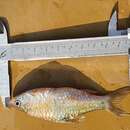Diseases and Parasites
provided by Fishbase
Anchor worm Disease. Parasitic infestations (protozoa, worms, etc.)
Diseases and Parasites
provided by Fishbase
Camallanus Disease. Parasitic infestations (protozoa, worms, etc.)
Diseases and Parasites
provided by Fishbase
Acanthogyrus Infestation 4. Parasitic infestations (protozoa, worms, etc.)
Diseases and Parasites
provided by Fishbase
Macrolecithus Disease. Parasitic infestations (protozoa, worms, etc.)
Diseases and Parasites
provided by Fishbase
Opistholebes Disease. Parasitic infestations (protozoa, worms, etc.)
Diseases and Parasites
provided by Fishbase
Steringotrema Disease. Parasitic infestations (protozoa, worms, etc.)
Migration
provided by Fishbase
Amphidromous. Refers to fishes that regularly migrate between freshwater and the sea (in both directions), but not for the purpose of breeding, as in anadromous and catadromous species. Sub-division of diadromous. Migrations should be cyclical and predictable and cover more than 100 km.Characteristic elements in amphidromy are: reproduction in fresh water, passage to sea by newly hatched larvae, a period of feeding and growing at sea usually a few months long, return to fresh water of well-grown juveniles, a further period of feeding and growing in fresh water, followed by reproduction there (Ref. 82692).
- Recorder
- Estelita Emily Capuli
Morphology
provided by Fishbase
Dorsal soft rays (total): 11 - 12; Analsoft rays: 8
Trophic Strategy
provided by Fishbase
Inhabits rivers, streams and ponds in plains and submontane regions (Ref. 41236). A very plentiful shoaling fish. Carnivore (Ref. 56237).
- Recorder
- Grace Tolentino Pablico
Biology
provided by Fishbase
Adults inhabit rivers, streams and ponds in plains and submontane regions (Ref. 41236). Collected from a large river with high turbid monsoon flow and with diverse substrate consisting of sand, mud, gravel, pebble, cobble, and boulders (Ref. 85713). A very plentiful shoaling fish. They remain small in domestic aquaria and become mature at 7 to 8 cm (Ref. 4832).
- Recorder
- Estelita Emily Capuli
Importance
provided by Fishbase
aquarium: public aquariums
- Recorder
- Estelita Emily Capuli
Pool barb
provided by wikipedia EN
The pool barb, spotfin swamp barb, or stigma barb (Puntius sophore) is a tropical freshwater and brackish fish belonging to the Puntius genus in the family Cyprinidae. It is native to inland waters in Asia and is found in India, Nepal, Bangladesh, Myanmar, Bhutan, Afghanistan, Pakistan and Yunnan, China.
Description
It reaches an adult size of 18 cm. (7 in) and a weight of 70 grams (2.5 ounces). The first maturity of female occurs at 4.7 cm. At the population level, size at 50% maturity (LM50) is 8.6-9.0 cm.[2]
Habitat
Its native habitat is rivers, streams, and ponds in plains and submontane regions. It is a plentiful shoaling fish.
Breeding
Pool barbs naturally breed within a temperature range 20–30 °C and>50 mm rainfall. The threshold gonadosomatic index (GSI) for breeding is 10.5 units in females. Females also need to attain a body fitness (Fulton's condition factor) of at least 1.6-1.7 units for successful spawning decision.[2]
Synonyms
This fish was originally named Cyprinus sophore by Francis Buchanan-Hamilton in 1822, and is also referred to as Systomus sophore, and Barbus sophore.
See also
References
-
^ Dahanukar, N. (2010). "Puntius sophore". IUCN Red List of Threatened Species. 2010: e.T166623A6249514. doi:10.2305/IUCN.UK.2010-4.RLTS.T166623A6249514.en. Retrieved 12 November 2021.
-
^ a b Sarkar, Uttam Kumar; Roy, Koushik; Naskar, Malay; Srivastava, Pankaj Kumar; Bose, Arun Kumar; Verma, Vinod Kumar; Gupta, Sandipan; Nandy, Saurav Kumar; Sarkar, Soma Das; Karnatak, Gunjan; Sudheesan, Deepa; Das, Basanta Kumar (2019). "Minnows may be more reproductively resilient to climatic variability than anticipated: Synthesis from a reproductive vulnerability assessment of Gangetic pool barbs (Puntius sophore)". Ecological Indicators. 105: 727–736. doi:10.1016/j.ecolind.2019.03.037.

- license
- cc-by-sa-3.0
- copyright
- Wikipedia authors and editors
Pool barb: Brief Summary
provided by wikipedia EN
The pool barb, spotfin swamp barb, or stigma barb (Puntius sophore) is a tropical freshwater and brackish fish belonging to the Puntius genus in the family Cyprinidae. It is native to inland waters in Asia and is found in India, Nepal, Bangladesh, Myanmar, Bhutan, Afghanistan, Pakistan and Yunnan, China.
- license
- cc-by-sa-3.0
- copyright
- Wikipedia authors and editors

